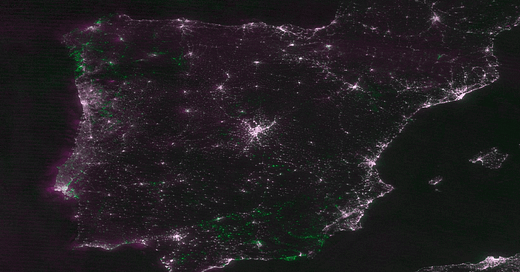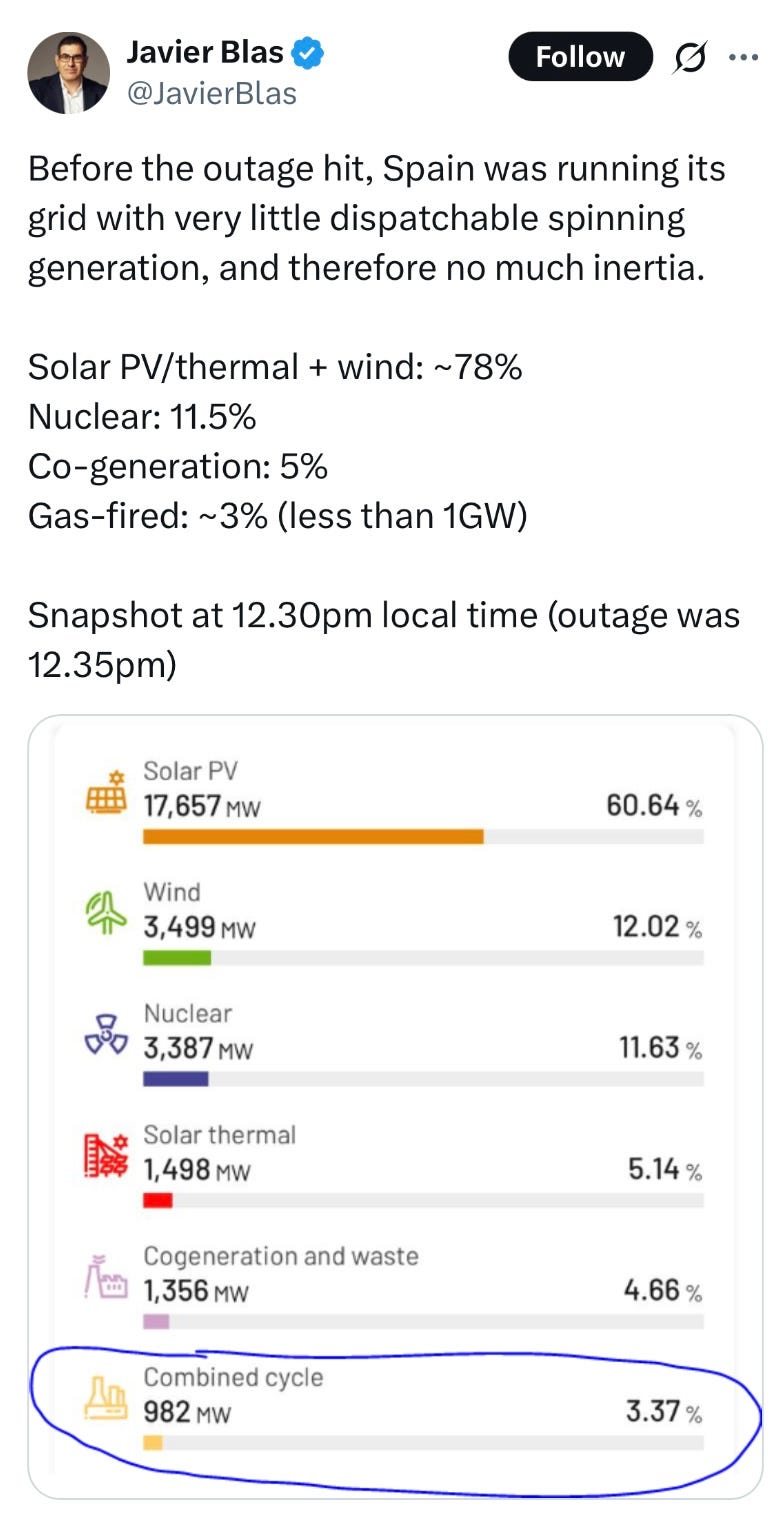Inertia, instability, and the Iberian blackout
How Spain’s renewable push exposed critical grid vulnerabilities

On the afternoon of Monday 28 April, something odd happened to Spain’s power grid. In just five minutes, between 12:30 and 12:35pm, the Iberian Peninsula lost around 60% of its total electricity generation. The grid didn’t just falter - it collapsed. Lights went out across Spain and Portugal. Trains stopped with people stuck on them. Lifts froze with people stuck in them. And while power was restored within a few hours, the sheer scale and speed of the failure was jaw-dropping.
What exactly happened? That’s the strange part: we still don’t know for certain. What we do know is that a massive voltage spike, possibly near southern Spain, triggered a wave of protective shutdowns. Power plants disconnected in rapid succession. Within seconds, the entire Iberian grid was cut off from the rest of Europe. The result: total blackout.
You might be wondering why I didn’t write about this back in April. The reason is a bit old-fashioned: I was waiting for facts. I wanted to see solid explanations before weighing in. But here we are, months later, and there’s still no definitive answer - just a lot of speculation and vague technical statements. So instead of waiting forever, let’s go over what we do know, and why it matters.
I read everything that came out as it was happening, hoping for clarity. But even 48 hours later, there were still no answers. Renewables advocates were blaming the blackout on nuclear, while nuclear advocates were pointing at renewables. One of the few solid facts that did emerge early on was that a cyberattack had been ruled out.
In a bizarre move, Portugal’s grid operator blamed Spain, attributing the blackout to something called an “induced atmospheric vibration,” which, if you’ve never heard of it before, you’re not alone. Supposedly, this rare atmospheric phenomenon triggered a voltage surge that set the whole cascade in motion.
But Spain didn’t endorse the theory. So we were left with duelling grid operators and a fancy name for “something strange happened.”
In June, Spain’s government and its grid operator finally weighed in, issuing separate reports on what they think went wrong. By then, the blackout had already become a kind of case study in modern grid fragility, but Spanish Prime Minister Pedro Sánchez pushed back on that argument, defending Spain’s aggressive clean energy rollout and called for patience. He also emphasised that the government wouldn’t “deviate a single millimetre” from its energy transition goals. By 2030, Spain wants to generate 81% of its electricity from renewables, and Sánchez made it clear that the blackout isn’t going to derail his wishes.
The Spanish government released a report blaming Spain’s grid operator, Redeia, arguing that Redeia miscalculated the right balance of sources, and when voltage started to spike, the system wasn’t prepared. Making matters worse, some conventional power plants (coal, gas, and nuclear) failed to stabilise the grid. Instead of absorbing the shock, they disconnected. That triggered a chain reaction of shutdowns, and the whole system unravelled. Or so they said.
It’s worth noting that Spain’s electricity system has turned upside down in just a few years, shutting down coal plants, scaling back gas, and pouring public money into wind and solar. The grid is a very different beast to manage now compared with what they’re used to. Spain generates nearly 57% of its electricity using renewable sources like wind, hydropower, and solar. At the same time, the country is phasing out its nuclear power plants, which adds complexity to managing the grid during periods of rapid change. Like Germany, they don’t want to hear any criticism of their energy transition plans.
Read my post on the Spanish nuclear phase-out:
I’m used to dealing with people who will use any data point to confirm what they already believe (confirmation bias remain undefeated), so I’ll admit that Prime Minister Sánchez’s response set off my spider sense. The speed and certainty with which he dismissed any connection to renewables felt more like political reflex than scientific caution.
But it’s hard to ignore the fact that something definitely went wrong with solar photovoltaics. In a matter of seconds, solar output plunged from 18,000 MW to just 8,000 MW. Since the sun obviously didn’t disappear, this must have been an automated command that shut down thousands of solar installations all at once.
As ever, Bloomberg columnist Javier Blas had important updates during the blackout. He tweeted:
Low inertia makes it harder for the grid to ride through sudden faults, and the Iberian grids have seen inertia drop sharply as inverter-based generation, especially solar, has grown. Lunchtime, when solar output peaks, is particularly vulnerable. The fact that this fault triggered a complete collapse of the Iberian grid, but was quickly contained at the French border, also points to low inertia in Spain and Portugal as a key factor.
For a detailed explanation of how this works, there’s a good write up in Power Magazine:
“The transition to renewable energy creates challenges for grid inertia. Wind turbines and solar panels are typically connected through power electronic converters, providing no natural inertial response. As conventional generators are retired, system inertia, short circuit response, and reactive power capabilities are all adversely affected, which makes power grids more vulnerable to frequency excursions and instability.”
If the problem was triggered by the disconnection of some solar plants in southwest Spain, the grid would normally balance this out through regulation, which is the mechanism that matches supply and demand in real time. As usual, this balancing was primarily done with hydropower. But at some point, the hydropower plants exhausted their ability to adjust, and the system couldn’t compensate any further.
Current evidence points to a problem with grid synchronisation. All power sources feeding into the grid have to operate at the same frequency - 50 Hertz. To keep this steady, the grid relies on stable baseload power from nuclear, gas, and hydroelectric plants. These sources act as a natural buffer, smoothing out disturbances and maintaining frequency stability when generation or demand suddenly shifts.
Variable renewables like solar photovoltaic, however, lack this capability. They produce direct current that’s converted to alternating current at 50 Hertz, but they can’t automatically adjust to frequency changes in real time.
We know that the Iberian grid has seen inertia decline due to the increasing penetration of inverter-based resources like solar PV, which don’t provide physical inertia. When I read up on inertia, I found a 2020 paper that examines it in detail, summarising that solar panels and wind turbines don’t directly sync with the grid like traditional generators. Instead, they use power electronics to convert their output, which means they don’t provide the natural “inertia” that helps stabilise the grid during sudden changes.
As this writer at The Conversation summarises, “The question is therefore not one of renewables versus nuclear, but rather how much solar power can be in the grid at any given moment while also maintaining stability.”
Coal, gas, and nuclear plants naturally help keep the grid stable because their big spinning turbines provide inertia. Wind and solar? Not so much. If this sounds like techno-jargon, Meredith Angwin’s book Shorting the Grid breaks it down into plain English and is well worth a read.
Germany has also integrated large amounts of renewable energy, particularly wind and solar, into its power grid. Like Spain, Germany’s growing reliance on inverter-based renewables has led to lower grid inertia, making it harder to maintain stable frequency during sudden disturbances. Germany has experienced occasional localised blackouts and near-misses that underscore the need for substantial upgrades in grid infrastructure, energy storage, and fast-reacting backup generation. The country’s ongoing phase-out of nuclear and coal plants adds further uncertainty, forcing grid operators to balance ambitious net zero targets with the practical realities of maintaining a reliable power supply.
So who is right? No one can claim ignorance here; we know that bringing renewables online at scale means overhauling regulations, investing in the grid, and changing how operators run the system. If you want reliable power and fewer blackouts, that’s just the price of admission. The most likely culprit, then, was a failure of old-school grid planning: not enough voltage control, not enough backup capacity, and not enough understanding of how to operate a novel grid in real-time.
This directly contradicts what the Spanish PM said, which was basically a refusal to admit the real challenges that come with cramming so much wind and solar onto the grid so quickly.
Meanwhile, an expert panel has been set up to investigate the root causes of the blackout, and their recommendations may be key in addressing how Spain moves forward. But ultimately, the exact outcome might be less important than the clear warning it sends to all countries rapidly integrating large amounts of wind and solar power. This event starkly highlights how dangerous poor grid integration can be when the system lacks sufficient stability, inertia, and backup capacity. No matter what the precise trigger is, the lesson is clear: countries need to take these technical challenges seriously and rethink plans to phase out reliable, stable power sources like nuclear energy before ensuring the grid can handle the variability and intermittency of renewables without risking catastrophic failures. Clean energy goals cannot come at the expense of grid reliability and public safety.
Finally, when nuclear disasters have occurred and officials haven’t been upfront about the causes, people have been angry about it. Now, Spanish officials need to avoid making the same mistakes, and look the facts squarely in the eye, or risk more outages later down the line. This event was a stark reminder that energy is life. Blackouts cost lives, and no amount of ideology is worth that.
If you want to stay ahead of the energy transition, this is your must-read. Subscribe now to get it first.
Already subscribed? Thanks for helping this newsletter grow, and feel free to forward it to one smart friend who cares about the future of reliable clean energy.







Well stated! All Power Engineers understand this critical concept. It will be very interesting if the politicians let the Engineers write the report!! We’ll be able to tell🤪🤪!
Thanks for your post. Californians for Green Nuclear Power (CGNP) is fighting the same problem in California. The aspiration of a large amount of solar and wind collides with the laws of physics and power engineering. Those physical laws are not influenced by politics.
CGNP created the GreenNUKE Substack over a year ago. Our first article is titled, "Why is Grid Inertia Important? Without sufficient synchronous grid inertia, the grid becomes unstable and a blackout occurs" https://greennuke.substack.com/p/why-is-grid-inertia-important.
CGNP learned of a unique Spanish tax on nuclear power. The tax subsidizes solar and wind, which produce low-quality, intermittent power that lacks synchronous grid inertia (SGI.) SGI maintains the steady "heartbeat" of the power grid. The Spanish politics employed a tax on their safe, abundant, 24/7/365 reliable nonpolluting nuclear power fleet. As a result, the politics dramatically changed the merit order for the Spanish power grid at mid-day. Two perfectly good nuclear power plants were off line on the morning of April 28, 2025. That change was enough to tip the balance to instability. See CGNP's July 8, 2025 article, "The Spanish Version of the 'Duck Curve' is a real killer This curve underscores the problem of insufficient synchronous grid inertia in Spain on April 28, 2025" for more details. https://greennuke.substack.com/p/the-spanish-version-of-the-duck-curve
See also Kilovar 1959's Substack article https://kilovar1959.substack.com/p/the-iberian-blackout-the-reports for additional technical details. Note the comments as well.